Coat of arms of Munster
The coat of arms of Munster consists of three gold crowns on a blue field. Similar crowns were included on the arms of Ireland before being superseded by the golden harp in the 16th century. The meaning of the crowns on the flag is not certain, but one possibility is that they may represent three of the medieval Hiberno-Norman lordships in Munster; the O’Briens (Thomond), the Butlers (Ormond) and the Fitzgeralds (Desmond).[1]
| Coat of arms of Munster | |
|---|---|
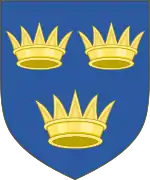 | |
| Armiger | Munster |
| Blazon | Azure, three antique crowns Or |
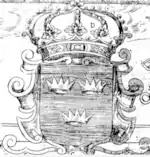
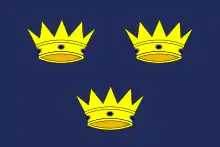
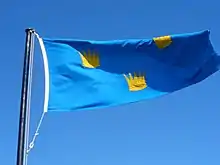
Similarly, the arms of Munster (dark blue, three antique crowns Or) is thought to have been derived from those of the former Lordship of Ireland, or from the short-lived dukedom of Ireland created for Robert de Vere in 1386. The crowns are now usually depicted as "antique" or "eastern": a gold rim with eight sharp, triangular rays, of which five are seen.[2][3]
History
For more than four hundred years, the Province of Munster has been heraldically symbolised by three golden antique crowns on a deep blue shield. The crowns may represent Thomond (Tuamhain, North Munster), Desmond (Deasumhain, South Munster), and Ormond (Urumhain, East Munster). While these arms are on record as relating to Munster as early as the sixteenth century, the motif, namely the antique Irish crown which inspired them, is considerably older. For example, a crown of the type now known as antique Irish, crafted in burnished metal and resting on a blue enamel surface, forms part of a thirteenth-century crozier head found near Cormac’s Chapel on the Rock of Cashel. This Gaelic Irish artifact is now in the National Museum of Ireland, Kildare Street, Dublin. Cashel was the seat of the Kings of Munster, from early Christian times through to the fifteenth century. In the case of the ‘king-bishops’ of Cashel, the placing of the antique crown on their crozier, could be interpreted as a symbolic assertion of their right to the political sovereignty of Munster. It is suggested therefore that the sovereignty of Munster, as expressed in heraldic format, uses the antique crown in triplicate. (Tripling of symbols in heraldic art is a convention used to achieve balance on the triangular surface of a shield.)[4]
As to the tincture (colour) of the Munster shield, in Gaelic mythology the sovereignty of Munster was personified in Mór Muman – a lady or goddess dressed in deep blue robes.[4]
The arms of the vice-admirals of Ireland in the 17th century incorporated what seem to be the arms of the respective provinces. Thus, it would appear that before the mid-1600s, the arms of Munster were represented as: Gules a cubit arm fessways holding a sword erect all proper,[5] probably deriving from the first arms of the O'Brien dynasty.
Modern forms and uses
The flag of Munster is usually displayed alongside the flags of Leinster, Ulster and Connacht, or as part of the combined flag of the Provinces of Ireland.
The Munster flag is the official flag of the Munster Gaelic Athletic Association and the Munster rugby team. The three crowns of the flag can also be seen on the Munster Rugby crest, and also the Munster GAA crest.
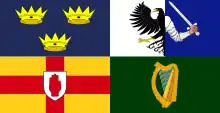
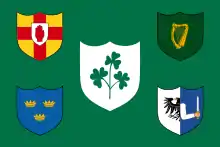 Ireland Rugby Union Flag
Ireland Rugby Union Flag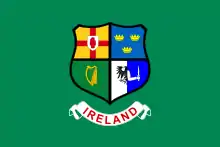 Flag of the Irish Hockey Team
Flag of the Irish Hockey Team
References
- Dan Corrigan. "Historical Roots". Archived from the original on 26 August 2011.
- Boutell, Charles; Fox-Davies, A. C. (1914), The Handbook to English Heraldry (Illustrated 11th ed.), Teddington, United Kingdom: The Echo Library, p. 160, ISBN 978-1-4068-2770-5
- Swyrich Corporation. "antique crown". Symbolism. Swyrich Corporation. Archived from the original on 25 January 2013. Retrieved 11 July 2011.
- The National Library of Ireland
- MacLysaght, Edward (1949). "Some Observations on the Arms of the Four Provinces". The Journal of the Royal Society of Antiquaries of Ireland. 79 (1/2): 60–63.